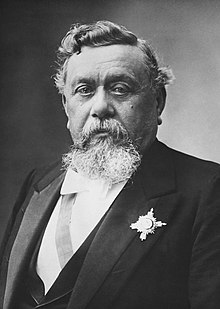Armand Fallières
Armand Fallières | |
|---|---|
 Fallières in 1906 | |
| 9th President of France | |
| In office 18 February 1906 – 18 February 1913 | |
| Prime Minister | Maurice Rouvier Ferdinand Sarrien Georges Clemenceau Aristide Briand Ernest Monis Joseph Caillaux Raymond Poincaré Aristide Briand |
| Preceded by | Émile Loubet |
| Succeeded by | Raymond Poincaré |
| Prime Minister of France | |
| In office 29 January 1883 – 21 February 1883 | |
| President | Jules Grévy |
| Preceded by | Charles Duclerc |
| Succeeded by | Jules Ferry |
| Personal details | |
| Born | 6 November 1841 Mézin, France |
| Died | 22 June 1931 (aged 89) Lannes, France |
| Political party | Democratic Republican Alliance |
| Alma mater | University of Paris |
| Signature |  |
Clément Armand Fallières (French pronunciation: [aʁmɑ̃ faljɛʁ]; 6 November 1841 – 22 June 1931) was a French statesman who was President of France from 1906 to 1913.
Clément Armand Fallières was a symbol of republicanism in the French Third Republic. He was born into a middle-class family in Lot-et-Garonne and became a lawyer and a Republican politician. He held various ministerial posts and was briefly prime minister in 1883. He had a moderate and sensitive approach to the religious problem, but was tough in dealing with labor unrest. In 1906, he became president of France, defeating Paul Doumer. According to David Bell, he had a talent for spotting political talent. His presidency was marked by his genial and reassuring manner, making him a popular figurehead. He was content with the procedural honors of a constitutional president and let his ministers make the decisions. His presidency emphasized the Senate's republicanism. He had the honour, though not the power, of presiding over the left-wing governing coalition known as the bloc des gauches ("left bloc").[1]
Early life
He was born at
In 1880 he became under-secretary of state in the department of the interior in
Political career

Fallières, who was ill at the time, was not able to face the storm of opposition, and resigned when the
He resigned in March 1885, becoming Minister of the Interior in Maurice Rouvier's cabinet two years later. He exchanged his portfolio in December for that of the department of justice. He returned again to the Ministry of the Interior in February 1889, and finally retook the department of justice from March 1890 to February 1892. In June 1890 his département (Lot-et-Garonne) elected him to the senate by 417 votes to 23. There Fallières remained independent of party struggles, although maintaining his influence among the Republicans.[2]
In March 1899 he was elected President of the Senate, and retained that position until January 1906, when he was chosen by a union of the groups of the Left in both chambers as candidate for the Presidency of the Republic. He was elected on the first ballot by 449 votes against 371 for his opponent, Paul Doumer.[2]
Fallières was an outspoken opponent of the death penalty and commuted the sentences of many prisoners sentenced to death.[citation needed]
Fallières' ministry, 29 January 1883 – 21 February 1883
- Armand Fallières – Minister of the Interior, and Minister of Worship
- Minister of War
- Minister of Finance
- Minister of Justice
- Minister of Marine and Colonies
- Minister of Public Instruction and Fine Arts
- Anne Charles Hérisson – Minister of Public Works
- Adolphe Cochery– Minister of Posts and Telegraphs
- Pierre Legrand – Minister of Commerce
Orders and decorations
 Spain: Grand Cross of the Royal and Distinguished Order of Charles III, with Collar, 19 June 1905[3]
Spain: Grand Cross of the Royal and Distinguished Order of Charles III, with Collar, 19 June 1905[3] Sweden: Knight of the Royal Order of the Seraphim, 27 April 1906[4]
Sweden: Knight of the Royal Order of the Seraphim, 27 April 1906[4] Order of Saint Olav, with Collar, 13 October 1906[5]
Order of Saint Olav, with Collar, 13 October 1906[5]- Siam: Knight of the Order of the Royal House of Chakri, 20 June 1907[6]
 Kingdom of Romania: Collar of the Order of Carol I, 1907[7]
Kingdom of Romania: Collar of the Order of Carol I, 1907[7] United Kingdom: Royal Victorian Chain, 29 May 1908[8]
United Kingdom: Royal Victorian Chain, 29 May 1908[8] Kingdom of Italy: Knight of the Supreme Order of the Most Holy Annunciation, 25 April 1909[9]
Kingdom of Italy: Knight of the Supreme Order of the Most Holy Annunciation, 25 April 1909[9] Order of Saint-Charles, 27 April 1909[10]
Order of Saint-Charles, 27 April 1909[10]
References
- ^ David Bell, et al. eds. Biographical dictionary of French political leaders since 1870 (1990) p. 142.
- ^ a b c d e Chisholm 1911.
- ^ "Real y distinguida orden de Carlos III". Guía Oficial de España. 1918. p. 211. Retrieved 21 March 2019.
- ^ "Kung. Svenska Riddareordnarna", Sveriges statskalender (in Swedish), 1915, p. 671 – via runeberg.org
- ^ "Den kongelige norske Sanct Olavs Orden", Norges Statskalender for Aaret 1930 (in Norwegian), Oslo: Forlagt av H. Aschehoug & Co. (w. Nygaard), 1930, pp. 995–996 – via runeberg.org
- Royal Thai Government Gazette (14 July 1907). "พระราชทานเครื่องราชอิสริยาภรณ์ มหาจักรีบรมราชวงษ์" (PDF) (in Thai). Archived from the original (PDF) on 8 May 2019. Retrieved 8 May 2019.)
{{cite journal}}: Cite journal requires|journal=(help - ^ "Ordinul Carol I" [Order of Carol I]. Familia Regală a României (in Romanian). Bucharest. Archived from the original on 6 May 2021. Retrieved 17 October 2019.
- ^ "No. 28141". The London Gazette. 29 May 1908. p. 3991.
- ^ Italy. Ministero dell'interno (1920). Calendario generale del regno d'Italia. p. 57.
- ^ "Journal de Monaco)" (PDF). gouv.mc (in French). 11 May 1909. Retrieved 4 May 2023.
- This article incorporates text from a publication now in the public domain: Chisholm, Hugh, ed. (1911). "Fallières, Clément Armand". Encyclopædia Britannica. Vol. 10 (11th ed.). Cambridge University Press. p. 154.
